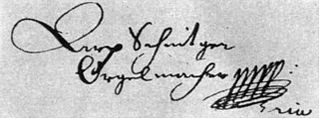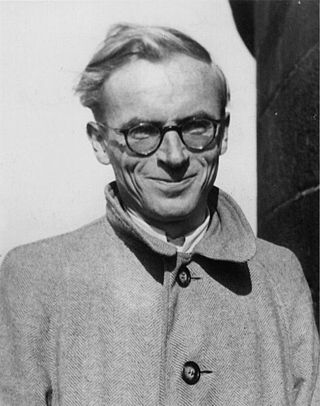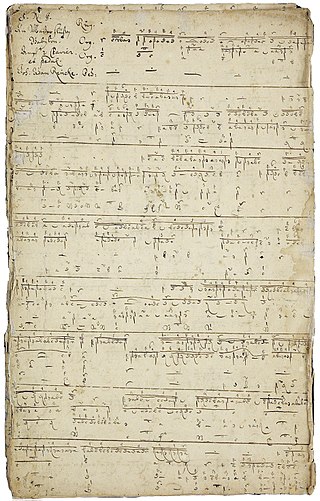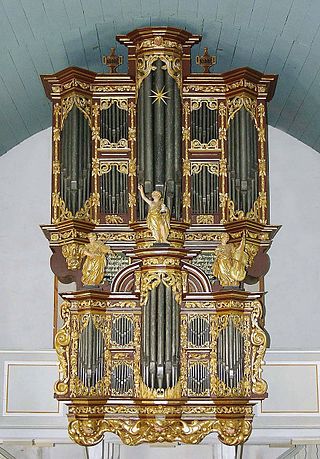
Harald Vogel (born 21 June 1941 in Ottersberg) is a German organist, organologist, and author. He is a leading expert on Renaissance and Baroque keyboard music. He has been professor of organ at the University of the Arts Bremen since 1994.

Harald Vogel (born 21 June 1941 in Ottersberg) is a German organist, organologist, and author. He is a leading expert on Renaissance and Baroque keyboard music. He has been professor of organ at the University of the Arts Bremen since 1994.
Arthur Emil Helmut Walcha was a German organist, harpsichordist, music teacher and composer who specialized in the works of the Dutch and German baroque masters.

Arp Schnitger was an influential Northern German organ builder. Considered the paramount manufacturer of his time, Schnitger built or rebuilt over 150 organs. He was primarily active in Northern Europe, especially the Netherlands and Germany, where a number of his instruments still survive.

Heinrich Scheidemann was a German organist and composer. He was the best-known composer for the organ in north Germany in the early to mid-17th century, and was an important forerunner of Dieterich Buxtehude and J.S. Bach.

August Hugo Distler was a German organist, choral conductor, teacher and composer.

The organ of the St. Jacobi Church in Hamburg, was built from 1689 to 1693 by the most renowned organ builder of his time, Arp Schnitger. The organ boasts four manuals and pedal with 60 stops, 15 of which are reeds – and has approximately 4000 sounding pipes. All in all, from the organ's original installation and its condition today not much of its conception has changed. The old pipework and the prospect pipes have been preserved in almost original format. It is the largest organ in existence from before 1700 and is one of the most eminent Baroque instruments that have been preserved.
The 17th century organ composers of Germany can be divided into two primary schools: the north German school and the south German school. The stylistic differences were dictated not only by teacher-pupil traditions and international influences, but also by separate organ building traditions: northern organs tend to have a tower layout with emphasis on the pedal division, while southern and Austrian instruments are typically divided around a window and emphasize manual divisions.
Käte van Tricht, was a German organist, pianist, harpsichordist, and pedagogue.

An Wasserflüssen Babylon is a chorale fantasia for organ by Johann Adam Reincken, based on "An Wasserflüssen Babylon", a 16th-century Lutheran hymn by Wolfgang Dachstein. Reincken likely composed the fantasia in 1663, partly as a tribute to Heinrich Scheidemann, his tutor and predecessor as organist at St. Catherine's Church, Hamburg. With its 327 bars, it is the most extended repertoire piece of this kind. Reincken's setting is a significant representative of the north German style of organ music.

The west gallery organ of the Martinikerk in Groningen dates from the 15th century; it took its present form in the 18th century when it was expanded by Arp Schnitger, his son Franz Caspar Schnitger and his successor Albertus Antonius Hinsz. It has 52 speaking stops on three manuals and pedal, and is one of the largest and most famous baroque organs in Northern Europe.

The organ of St. Peter and Paul in Cappel was built in 1680 by Arp Schnitger for the St. Johannis-Klosterkirche in Hamburg and has been in Cappel, Lower Saxony since 1816. It is considered to be the most complete and sonically best-preserved organ from the late 17th century in northern Germany. The instrument has two manuals with pedal and 30 stops, of which only two are not entirely old. Helmut Walcha's recordings of Bach's organ works (1950–1952) made this instrument world-famous.

The organ of St. Ludgeri in Norden was built from 1686 to 1692 by Arp Schnitger. It has 46 stops, five divisions, three manuals and pedal, and is thus the second-largest surviving Schnitger organ in Germany and until 2018 the largest organ in East Frisia. Historically and musically it is considered an art-work of international rank.

The organ of the St. Pankratius in Hamburg-Neuenfelde was built in 1688 by Arp Schnitger, and is his largest two-manual organ. The instrument has 34 stops, of which about half are original. Neuenfelde itself belongs to the Altes Land and was incorporated to Hamburg in 1937.

Wolfgang Baumgratz is a German organist and academic teacher. He is the organist of the Bremer Dom, and professor of organ at the Hochschule für Künste Bremen. He has toured in Europe as a concert organist and made recordings. He was president of the international association Gesellschaft der Orgelfreunde from 1998 to 2013.
Stef Tuinstra is a Dutch organist, organ expert and author.
Gustav Fock was a German music historian, editor early music and organologist. He is considered the most important Schnitger researcher of his time.
Gottfried Fritzsche was a German organ builder.
Johann Dietrich Busch was a German organ builder.
Johann Hinrich Klapmeyer was a German organ builder.

Bernhardt Hilbrand Edskes was a Dutch-Swiss organist, organologist, and organ builder based in Wohlen.
Franz Caspar Schnitger was a German organ-builder active in the Netherlands.